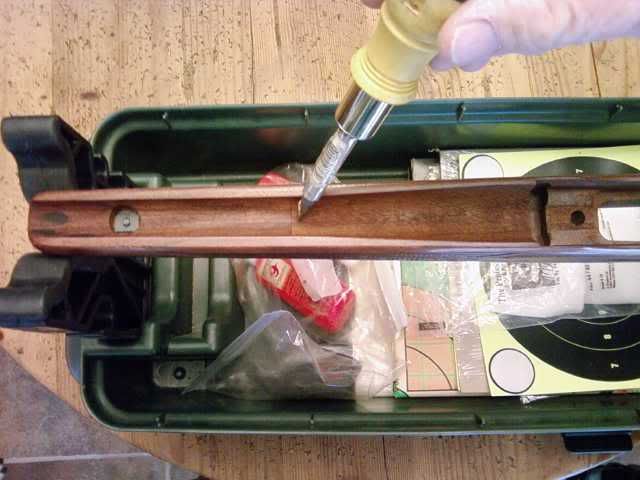Like the title says. i own a .25-06 model 70 and according to the serial number. it's equipped with the original walnut stock. the problem i am having is the barrel is contacting the stock. my question is, was this year model designed to with contact points(barrel stock) or was it free floated? would appreciate any input from you experts.. thanks
You are using an out of date browser. It may not display this or other websites correctly.
You should upgrade or use an alternative browser.
You should upgrade or use an alternative browser.
1972 model 70 .25-06
- Thread starter jeepman
- Start date
I have a .243 of the same vintage as your 06 , it had a contact pad at the forend tip . Had is the key word here , I removed the pad , and did some other judisious sanding . My group size was reduced by 50% . If you remove the contact pad and your rifle doesn't shoot better or maybe shoots worse , you can always put it back with a little epoxy . Oh and welcome to TFL , lots of brains to pick here , some even have content !
After examining the stock closely, the slightly raised contact point on my stock starts about 5" back from the end of the fore end.my barrel is contacting the stock at the end of the fore end lol.sorry if this sounds confusing.
That sounds about right. Some rifles shoot very well with a contact patch, some benefit from free-floating. How will you know which is best for your rifle? You won't know until you free float it.
If the rifle meets your criteria in unmodified form, then don't modify it. If it doesn''t shoot the way you want it to shoot, then float the barrel and see what difference that makes. Either way, it's your rifle.

I have had another model 70 just like this one and never had the barrel rub and leave bluing marks on the stock. look closely, there is one in the center and left side of stock near the end of the fore end.all i am looking to do is fix the current problem. i never said i wanted to float the barrel lol.
If you want to relieve the contact points the easiest way is whats been suggested. Float the barrel.
You won't be hurting anything, its just sanding the channel.
Search it online, I'm fairly certain you can find complete instructions.
Its really simple though, just work slowly and take it down till you can run a dollar bill freely between the barrel and stock.
You won't be hurting anything, its just sanding the channel.
Search it online, I'm fairly certain you can find complete instructions.
Its really simple though, just work slowly and take it down till you can run a dollar bill freely between the barrel and stock.
All you need to do is get a wooden doll and some medium to fine sandpaper. Rap the sand paper around the doll and sand the channel a little. Put the action back in, tighten it down and see if a dollar biller will slide “snugly” between the barrel and the stock. Repeat until the bill slides between the two. Take it slow, if you take out too much wood you’ve taken out too much. Won’t really hurt anything but might not look good. It’s pretty simple just takes a little time and patience. As the others have said, this IS called free-floating the barrel. If it’s not free-floated it WILL make contact and leaave black marks.
Good photo! The contact patch is easy to see. If you look toward the forend of the stock, you'll see another black mark where the barrel is touching the stock.
That doesn't make any sense. You can't "repair" the problem without floating the barrel. For that matter, we don't know if it is a problem, how does the rifle shoot? Some rifles need a contact patch for best accuracy, others don't need that patch, and you won't know until you shoot the rifle. Either way, it won't make any difference in the eventual sales price. A '72 model 25-06 is probably a push-feed and those don't normally command a premium price.
Either float the barrel or don't. That's up to you. If the contact patch is a problem the only way to cure the problem is to sand it out of there. And, it's a very easy fix. Now that you have the action out of the stock, you've done 90% of the work. Ten minutes with a dowel and a piece of sandpaper and that contact patch will be gone. Put a sealer on the sanded wood, let it dry and re-install the stock.
I really would like to just repair the existing problem and not free float the barrel.
That doesn't make any sense. You can't "repair" the problem without floating the barrel. For that matter, we don't know if it is a problem, how does the rifle shoot? Some rifles need a contact patch for best accuracy, others don't need that patch, and you won't know until you shoot the rifle. Either way, it won't make any difference in the eventual sales price. A '72 model 25-06 is probably a push-feed and those don't normally command a premium price.
Either float the barrel or don't. That's up to you. If the contact patch is a problem the only way to cure the problem is to sand it out of there. And, it's a very easy fix. Now that you have the action out of the stock, you've done 90% of the work. Ten minutes with a dowel and a piece of sandpaper and that contact patch will be gone. Put a sealer on the sanded wood, let it dry and re-install the stock.
